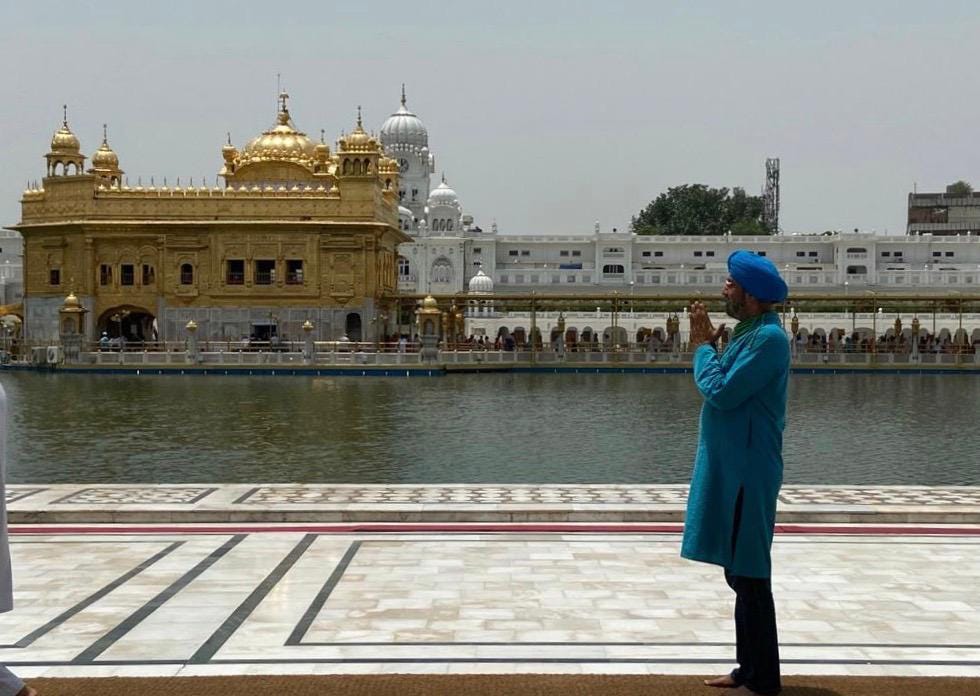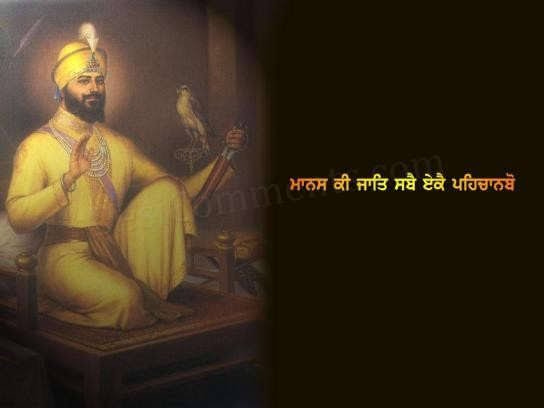The Four Yugas: A Timeless Message of Guru Ram Das Ji in Sri Guru Granth Sahib
Guru Sahib explains that in the darkness of Kali Yuga, the true Guru’s teachings and remembrance of God's Name (Naam) shine as an indispensable guiding light for ordinary souls like us.
Four Yugas as Explained by the Fourth Nanak
In these sacred verses on Ang 445-446 of the Sri Guru Granth Sahib, Guru Ram Das Ji offers profound insights into the evolution of human spirituality across the four Yugas. He illustrates how, from the Golden Age of Sat Yuga to the current Iron Age of Kali Yuga, the foundation of righteousness (dharma) has gradually weakened, leaving humanity more susceptible to ego, anger, and attachment. Earlier ages were rooted in strong spiritual and moral virtues, supported by the complete foundation of dharma. However, Kali Yuga, the present age, is marked by a decline in these virtues, where true spirituality is scarce, and worldly distractions obscure the soul’s natural inclination toward divinity.
Yet, in even this dark age, Guru Sahib assures us that the path to divine connection and inner peace remains accessible. Through the message of the true Guru—the divine wisdom imparted in the Guru’s Shabad and the remembrance of God's Name—ordinary souls can transcend the challenges of Kali Yuga and reconnect with their higher purpose, finding clarity, fulfilment, and union with the Divine.
Sat Yuga
Verse 1
Gurmukhi: ਆਸਾ ਮਹਲਾ ੪ ॥
Transliteration: Aasaa mėhlaa 4.
Translation: Aasaa, Fourth Mehl.
Explanation: This hymn is composed by the fourth Guru, Guru Ram Das Ji, in Raga Aasaa, setting a devotional tone for the verses.
Verse 2
Gurmukhi: ਸਤਜੁਗਿ ਸਭੁ ਸੰਤੋਖ ਸਰੀਰਾ ਪਗ ਚਾਰੇ ਧਰਮੁ ਧਿਆਨੁ ਜੀਉ ॥
Transliteration: Saṫjug sabʰ sanṫokʰ sareeraa pag chaaré ḋʰaram ḋʰi▫aan jee▫o.
Translation: In the Golden Age of Sat Yuga, everyone embodied contentment and meditation; religion stood upon four feet.
Explanation: Sat Yuga, the age of truth, saw humanity embodying contentment and spiritual focus, with dharma fully intact and supported by four pillars: truth, purity, compassion, and discipline.
Verse 3
Gurmukhi: ਮਨਿ ਤਨਿ ਹਰਿ ਗਾਵਹਿ ਪਰਮ ਸੁਖੁ ਪਾਵਹਿ ਹਰਿ ਹਿਰਦੈ ਹਰਿ ਗੁਣ ਗਿਆਨੁ ਜੀਉ ॥
Transliteration: Man ṫan har gaavahi param sukʰ paavahi har hirḋæ har guṇ gi▫aan jee▫o.
Translation: With mind and body, they sang of the Lord, and attained supreme peace. In their hearts was the spiritual wisdom of the Lord’s Glorious Virtues.
Explanation: People devoted their minds and bodies to the praise of God, finding profound peace and filling their hearts with divine knowledge and virtues.
Verse 4
Gurmukhi: ਗੁਣ ਗਿਆਨੁ ਪਦਾਰਥੁ ਹਰਿ ਹਰਿ ਕਿਰਤਾਰਥੁ ਸੋਭਾ ਗੁਰਮੁਖਿ ਹੋਈ ॥
Transliteration: Guṇ gi▫aan paḋaaraṫʰ har har kirṫaaraṫʰ sobʰaa gurmukʰ ho▫ee.
Translation: Their wealth was the spiritual wisdom of the Lord’s Glorious Virtues; the Lord was their success, and to live as Gurmukh was their glory.
Explanation: Spiritual virtues were their true wealth, and living a Gurmukh life—focused on the Guru and God—was their honour.
Verse 5
Gurmukhi: ਅੰਤਰਿ ਬਾਹਰਿ ਹਰਿ ਪ੍ਰਭੁ ਏਕੋ ਦੂਜਾ ਅਵਰੁ ਨ ਕੋਈ ॥
Transliteration: Anṫar baahar har parabʰ éko ḋoojaa avar na ko▫ee.
Translation: Inwardly and outwardly, they saw only the One Lord God; for them there was no other second.
Explanation: People of Sat Yuga were singularly focused on God, recognising His presence in everything and everyone.
Verse 6
Gurmukhi: ਹਰਿ ਹਰਿ ਲਿਵ ਲਾਈ ਹਰਿ ਨਾਮੁ ਸਖਾਈ ਹਰਿ ਦਰਗਹ ਪਾਵੈ ਮਾਨੁ ਜੀਉ ॥
Transliteration: Har har liv laa▫ee har naam sakʰaa▫ee har ḋargėh paavæ maan jee▫o.
Translation: They centered their consciousness lovingly on the Lord, Har, Har. The Lord’s Name was their companion, and in the Court of the Lord, they obtained honour.
Explanation: By focusing their hearts on God’s Name, they attained divine honour in His court.
Verse 7
Gurmukhi: ਸਤਜੁਗਿ ਸਭੁ ਸੰਤੋਖ ਸਰੀਰਾ ਪਗ ਚਾਰੇ ਧਰਮੁ ਧਿਆਨੁ ਜੀਉ ॥੧॥
Transliteration: Saṫjug sabʰ sanṫokʰ sareeraa pag chaaré ḋʰaram ḋʰi▫aan jee▫o. ||1||
Translation: In the Golden Age of Sat Yuga, everyone embodied contentment and meditation; religion stood upon four feet. ||1||
Explanation: Re-emphasising that dharma stood complete in Sat Yuga, supporting righteousness in all facets of life.
Trayta Yuga
Verse 8
Gurmukhi: ਤੇਤਾ ਜੁਗੁ ਆਇਆ ਅੰਤਰਿ ਜੋਰੁ ਪਾਇਆ ਜਤੁ ਸੰਜਮ ਕਰਮ ਕਮਾਇ ਜੀਉ ॥
Transliteration: Ṫéṫaa jug aa▫i▫aa anṫar jor paa▫i▫aa jaṫ sanjam karam kamaa▫é jee▫o.
Translation: Then came the Silver Age of Trayta Yuga; men’s minds were ruled by power, and they practiced celibacy and self-discipline.
Explanation: Trayta Yuga marked a decline in spiritual inclination, where people relied on discipline and strength to sustain righteousness.
Verse 9
Gurmukhi: ਪਗੁ ਚਉਥਾ ਖਿਸਿਆ ਤ੍ਰੈ ਪਗ ਟਿਕਿਆ ਮਨਿ ਹਿਰਦੈ ਕ੍ਰੋਧੁ ਜਲਾਇ ਜੀਉ ॥
Transliteration: Pag cha▫uṫʰaa kʰisi▫aa ṫaræ pag tiki▫aa man hirḋæ kroḋʰ jalaa▫é jee▫o.
Translation: The fourth foot of religion dropped off, and three remained. Their hearts and minds were inflamed with anger.
Explanation: One leg of dharma was lost in Trayta Yuga, allowing anger to infiltrate people’s hearts.
Verse 10
Gurmukhi: ਮਨਿ ਹਿਰਦੈ ਕ੍ਰੋਧੁ ਮਹਾ ਬਿਸਲੋਧੁ ਨਿਰਪ ਧਾਵਹਿ ਲੜਿ ਦੁਖੁ ਪਾਇਆ ॥
Transliteration: Man hirḋæ kroḋʰ mahaa bisloḋʰ nirap ḋʰaavėh laṛ ḋukʰ paa▫i▫aa.
Translation: Their hearts and minds were filled with the horribly poisonous essence of anger. The kings fought their wars and obtained only pain.
Explanation: Rulers, driven by ego, engaged in wars and experienced suffering, showing the destructive power of unchecked anger.
Verse 11
Gurmukhi: ਅੰਤਰਿ ਮਮਤਾ ਰੋਗੁ ਲਗਾਨਾ ਹਉਮੈ ਅਹੰਕਾਰੁ ਵਧਾਇਆ ॥
Transliteration: Anṫar mamṫaa rog lagaanaa ha▫umæ ahaⁿkaar vaḋʰaa▫i▫aa.
Translation: Their minds were afflicted with the illness of egotism, and their self-conceit and arrogance increased.
Explanation: Attachment and ego grew, diminishing humility and filling individuals with pride.
Verse 12
Gurmukhi: ਹਰਿ ਹਰਿ ਕ੍ਰਿਪਾ ਧਾਰੀ ਮੇਰੈ ਠਾਕੁਰਿ ਬਿਖੁ ਗੁਰਮਤਿ ਹਰਿ ਨਾਮਿ ਲਹਿ ਜਾਇ ਜੀਉ ॥
Transliteration: Har har kirpaa ḋʰaaree méræ tʰaakur bikʰ gurmaṫ har naam lėh jaa▫é jee▫o.
Translation: If my Lord, Har, Har, shows His Mercy, my Lord and Master eradicates the poison by the Guru’s Teachings and the Lord’s Name.
Explanation: Divine mercy, through the Guru’s teachings, removes the poison of ego and attachment, restoring purity.
Verse 13
Gurmukhi: ਤੇਤਾ ਜੁਗੁ ਆਇਆ ਅੰਤਰਿ ਜੋਰੁ ਪਾਇਆ ਜਤੁ ਸੰਜਮ ਕਰਮ ਕਮਾਇ ਜੀਉ ॥੨॥
Transliteration: Ṫéṫaa jug aa▫i▫aa anṫar jor paa▫i▫aa jaṫ sanjam karam kamaa▫é jee▫o. ||2||
Translation: Then came the Silver Age of Trayta Yuga; men’s minds were ruled by power, and they practiced celibacy and self-discipline. ||2||
Explanation: This verse reiterates the moral decline of Trayta Yuga, highlighting the reliance on discipline.
Dwaapar Yuga
Verse 14
Gurmukhi: ਜੁਗੁ ਦੁਆਪੁਰੁ ਆਇਆ ਭਰਮਿ ਭਰਮਾਇਆ ਹਰਿ ਗੋਪੀ ਕਾਨੑੁ ਉਪਾਇ ਜੀਉ ॥
Transliteration: Jug ḋu▫aapur aa▫i▫aa bʰaram bʰarmaa▫i▫aa har gopee kaanĥ upaa▫é jee▫o.
Translation: The Brass Age of Dwaapar Yuga came, and people wandered in doubt. The Lord created the Gopis and Krishna.
Explanation: In Dwaapar Yuga, confusion arose, and divine manifestations like Krishna helped guide humanity.
Verse 15
Gurmukhi: ਤਪੁ ਤਾਪਨ ਤਾਪਹਿ ਜਗ ਪੁੰਨ ਆਰੰਭਹਿ ਅਤਿ ਕਿਰਿਆ ਕਰਮ ਕਮਾਇ ਜੀਉ ॥
Transliteration: Ṫap ṫaapan ṫaapėh jag punn aarambʰėh aṫ kiri▫aa karam kamaa▫é jee▫o.
Translation: The penitents practiced penance, they offered sacred feasts and charity, and performed many rituals and religious rites.
Explanation: People took up rituals and charitable acts to maintain spiritual focus amidst increasing doubt.
Verse 16
Gurmukhi: ਕਿਰਿਆ ਕਰਮ ਕਮਾਇਆ ਪਗ ਦੁਇ ਖਿਸਕਾਇਆ ਦੁਇ ਪਗ ਟਿਕੈ ਟਿਕਾਇ ਜੀਉ ॥
Transliteration: Kiri▫aa karam kamaa▫i▫aa pag ḋu▫é kʰiskaa▫i▫aa ḋu▫é pag tikæ tikaa▫é jee▫o.
Translation: They performed many rituals and religious rites; two legs of religion dropped away, and only two legs remained.
Explanation: The foundation of dharma weakened further, despite external ritualistic practices, leaving only two pillars intact.
Verse 17
Gurmukhi: ਮਹਾ ਜੁਧ ਜੋਧ ਬਹੁ ਕੀਨੑੇ ਵਿਚਿ ਹਉਮੈ ਪਚੈ ਪਚਾਇ ਜੀਉ ॥
Transliteration: Mahaa juḋʰ joḋʰ baho keenĥé vich ha▫umæ pachæ pachaa▫é jee▫o.
Translation: So many heroes waged great wars; in their egos they were ruined, and they ruined others as well.
Explanation: Driven by ego, warriors fought great wars, causing widespread ruin and deepening moral decay.
Verse 18
Gurmukhi: ਦੀਨ ਦਇਆਲਿ ਗੁਰੁ ਸਾਧੁ ਮਿਲਾਇਆ ਮਿਲਿ ਸਤਿਗੁਰ ਮਲੁ ਲਹਿ ਜਾਇ ਜੀਉ ॥
Transliteration: Ḋeen ḋa▫i▫aal gur saaḋʰ milaa▫i▫aa mil saṫgur mal lėh jaa▫é jee▫o.
Translation: The Lord, Compassionate to the poor, led them to meet the Holy Guru. Meeting the True Guru, their filth is washed away.
Explanation: Divine compassion led people to the Guru, whose teachings cleansed their impurities and restored righteousness.
Verse 19
Gurmukhi: ਜੁਗੁ ਦੁਆਪੁਰੁ ਆਇਆ ਭਰਮਿ ਭਰਮਾਇਆ ਹਰਿ ਗੋਪੀ ਕਾਨੑੁ ਉਪਾਇ ਜੀਉ ॥੩॥
Transliteration: Jug ḋu▫aapur aa▫i▫aa bʰaram bʰarmaa▫i▫aa har gopee kaanĥ upaa▫é jee▫o. ||3||
Translation: The Brass Age of Dwaapar Yuga came, and the people wandered in doubt. The Lord created the Gopis and Krishna. ||3||
Explanation: This line reiterates the arrival of Dwaapar Yuga, with the divine manifestation of Krishna guiding people through doubt.
Kali Yuga
Verse 20
Gurmukhi: ਕਲਿਜੁਗੁ ਹਰਿ ਕੀਆ ਪਗ ਤ੍ਰੈ ਖਿਸਕੀਆ ਪਗੁ ਚਉਥਾ ਟਿਕੈ ਟਿਕਾਇ ਜੀਉ ॥
Transliteration: Kalijug har kee▫aa pag ṫaræ kʰiskee▫aa pag cha▫uṫʰaa tikæ tikaa▫é jee▫o.
Translation: The Lord ushered in the Dark Age, the Iron Age of Kali Yuga; three legs of religion were lost, and only the fourth leg remained intact.
Explanation: In Kali Yuga, the current age, dharma’s foundation is extremely weak, supported only by a single pillar, symbolising minimal adherence to truth.
Verse 21
Gurmukhi: ਗੁਰ ਸਬਦੁ ਕਮਾਇਆ ਅਉਖਧੁ ਹਰਿ ਪਾਇਆ ਹਰਿ ਕੀਰਤਿ ਹਰਿ ਸਾਂਤਿ ਪਾਇ ਜੀਉ ॥
Transliteration: Gur sabaḋ kamaa▫i▫aa a▫ukʰaḋʰ har paa▫i▫aa har keeraṫ har saaⁿṫ paa▫é jee▫o.
Translation: Acting in accordance with the Word of the Guru’s Shabad, the medicine of the Lord’s Name is obtained. Singing the Kirtan of the Lord’s Praises, divine peace is obtained.
Explanation: In Kali Yuga, where dharma is fragile, the Guru’s teachings are essential. Following the Guru’s Shabad and praising God are the primary means of finding inner peace and balance.
Verse 22
Gurmukhi: ਹਰਿ ਕੀਰਤਿ ਰੁਤਿ ਆਈ ਹਰਿ ਨਾਮੁ ਵਡਾਈ ਹਰਿ ਹਰਿ ਨਾਮੁ ਖੇਤੁ ਜਮਾਇਆ ॥
Transliteration: Har keeraṫ ruṫ aa▫ee har naam vadaa▫ee har har naam kʰéṫ jamaa▫i▫aa.
Translation: The season of singing the Lord’s Praise has arrived; the Lord’s Name is glorified, and the Name of the Lord, Har, Har, grows in the field of the body.
Explanation: This verse symbolises the need for remembrance and devotion in Kali Yuga. The mind is likened to a field where the seeds of God’s Name should be sown to cultivate inner virtues.
Verse 23
Gurmukhi: ਕਲਿਜੁਗਿ ਬੀਜੁ ਬੀਜੇ ਬਿਨੁ ਨਾਵੈ ਸਭੁ ਲਾਹਾ ਮੂਲੁ ਗਵਾਇਆ ॥
Transliteration: Kalijug beej beejé bin naavæ sabʰ laahaa mool gavaa▫i▫aa.
Translation: In the Dark Age of Kali Yuga, if one plants any other seed than the Name, all profit and capital is lost.
Explanation: This line warns that worldly pursuits without God’s remembrance yield no true benefit in Kali Yuga. Only actions rooted in the Divine Name bring lasting value.
Verse 24
Gurmukhi: ਜਨ ਨਾਨਕਿ ਗੁਰੁ ਪੂਰਾ ਪਾਇਆ ਮਨਿ ਹਿਰਦੈ ਨਾਮੁ ਲਖਾਇ ਜੀਉ ॥
Transliteration: Jan Naanak gur pooraa paa▫i▫aa man hirḋæ naam lakʰaa▫é jee▫o.
Translation: Servant Nanak has found the Perfect Guru, who has revealed to him the Naam within his heart and mind.
Explanation: Here, Guru Ram Das Ji recalls Guru Nanak’s spiritual journey, emphasising that the Guru alone can awaken divine awareness within the heart.
Verse 25
Gurmukhi: ਕਲਜੁਗੁ ਹਰਿ ਕੀਆ ਪਗ ਤ੍ਰੈ ਖਿਸਕੀਆ ਪਗੁ ਚਉਥਾ ਟਿਕੈ ਟਿਕਾਇ ਜੀਉ ॥੪॥੪॥੧੧॥
Transliteration: Kaljug har kee▫aa pag ṫaræ kʰiskee▫aa pag cha▫uṫʰaa tikæ tikaa▫é jee▫o. ||4||4||11||
Translation: The Lord ushered in the Dark Age, the Iron Age of Kali Yuga; three legs of religion were lost, and only the fourth leg remained intact. ||4||4||11||
Explanation: This closing line summarises the gradual decline of dharma across ages, culminating in Kali Yuga, where only a single leg of righteousness, the pillar of truth, remains intact.
Summing Up— The True Guru’s Shabad Illuminates the Path for the Terrestrial Seeker
In these divine verses, Guru Ram Das Ji provides a timeless message that resonates deeply with the struggles and spiritual challenges of our age, Kali Yuga. As dharma declined through the four Yugas, the reliance on external rituals and power gradually overtook natural righteousness and inner spirituality. Now, in the present age, we face the weakest foundation of righteousness—supported only by the pillar of truth. It is an era where doubt, ego, and material distractions obscure the path to divine connection.
Yet, Guru Sahib’s divine words offer us a beacon of hope and a clear path forward. He reminds us that, while Kali Yuga may be an age of darkness, it is precisely in such times that the true Guru’s teachings become indispensable. The Guru’s wisdom and the remembrance of God's Name serve as a guiding light for ordinary souls like us. Through the Guru’s Shabad—the divine Word—we can cleanse ourselves of ego, attachments, and worldly poisons that cloud our minds. By holding fast to the Guru’s message and immersing ourselves in the divine Name, we cultivate inner peace and divine understanding.
In this way, the teachings of the Guru stand as the sole anchor of truth and righteousness in Kali Yuga, illuminating a path of love, humility, and devotion for all seekers1. The true Guru's message empowers us to rise above the illusions of this age and connect with the eternal light within, leading us to spiritual fulfilment and unity with the Divine2.
In Hindu cosmology, the concept of time is divided into four cyclical eras known as Yugas, each with distinct characteristics, spiritual attributes, and durations. These Yugas are:
Satya Yuga (Golden Age): Known as the age of truth and righteousness, Satya Yuga is the longest Yuga, lasting 1,728,000 years. Humanity in this era was spiritually elevated, characterised by great strength, longevity, and harmony with nature. Meditation and moral integrity were paramount, with no social disparity or conflict.
Treta Yuga (Silver Age): Lasting 1,296,000 years, Treta Yuga saw a shift toward religious sacrifices and the worship of deities. The class-based system, or varnashrama, was introduced, shaping social structure and duties. While spiritual practices continued, a gradual decline in overall virtue began.
Dvapara Yuga (Bronze Age): With a duration of 864,000 years, Dvapara Yuga marked further decline in righteousness. Evil and societal conflicts increased, and warfare became more common. This era also saw the composition of various shastras, or sacred texts, including Ayurveda and Jyotisha, as humanity sought order amidst increasing chaos.
Kali Yuga (Iron Age): The current and shortest Yuga, lasting 432,000 years, began in 3102 BCE. Kali Yuga is characterised by widespread moral decay, with theft, falsehood, and egotism prevailing. Religious practices and social order have weakened significantly, reflecting a decline in virtue.
The Yugas follow a 4:3:2:1 ratio in duration and virtue, with each era shorter and less spiritually elevated than the one before. Together, these four Yugas form a Mahayuga or Chaturyuga, which spans 4,320,000 years (12,000 divine years). In this cyclical view of time, each Mahayuga repeats endlessly, marking the rhythm of cosmic and human history. Each Yuga’s duration is based on divine years, where one divine year equals 360 human years, underscoring the vast, cyclical nature of time in Hindu cosmology.






ਨਾਨਕ ਕੈ ਘਰਿ ਕੇਵਲ ਨਾਮੁ।।
ਏਕੋ ਨਾਮੁ ਹੁਕਮੁ ਹੈ ਨਾਨਕ ਸਤਿਗੁਰਿ ਦੀਆ ਬੁਝਾਇ ਜੀਉ ।
ਗੁਰੂ ਦੁਆਰੈ ਹੋਇ ਸੋਝੀ ਪਾਇਸੀ ।।
ਹਰ ਮਨੁੱਖ ਦੀ ਚੇਤਨਾ ਵਿੱਚ ਪ੍ਰਮਾਤਮਾ ਨੂੰ ਮਿਲਣ ਦੀ ਤਾਂਘ ਹੁੰਦੀ ਹੈ ਪਰ ਆਤਮਿਕ ਗਿਆਨ ਦੀ ਅਣਹੋਂਦ ਕਾਰਨ ਉਹ ਕਰਮਾਂ ਕਾਂਡਾਂ ਵਿੱਚ ਹੀ ਫਸਿਆ ਰਹਿੰਦਾ ਹੈ।
ਗੁਰੂ ਸਾਹਿਬ ਵੱਲੋਂ ਬਖਸ਼ਿਸ਼ ਕੀਤੇ ਗਿਆਨ ਦੇ ਅਨੁਸਾਰੀ ਹੋ ਕੇ ਹੀ ਉਸ ਵਿੱਚ ਅਭੇਦਤਾ ਪ੍ਰਾਪਤ ਸੰਭਵ ਹੈ।
ਬਹੁਤ ਮੇਹਨਤ ਨਾਲ ਤੂਹਾਡੇ ਵੱਲੋਂ ਤਿਆਰ ਕੀਤਾ ਅੱਜ ਦਾ ਪ੍ਰਸੰਗ ਬਹੁਤ ਹੀ ਮਹੱਤਵਪੂਰਨ ਹੈ ਜੀ। ਅਜਿਹੀਆਂ ਜਾਣਕਾਰੀਆਂ ਜ਼ਰੂਰ ਸਾਂਝੀਆਂ ਕਰਦੇ ਰਿਹਾ ਕਰੋ ਜੀ।
ਨਿਸ਼ਾਨ ਸਿੰਘ ਕਾਹਲੋਂ
…….an outstanding article of true wisdom…….is it not inspired by one word “Kalyug”.. mentioned in someone’ comment..?